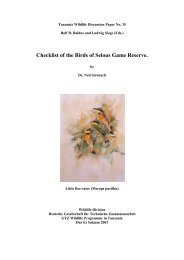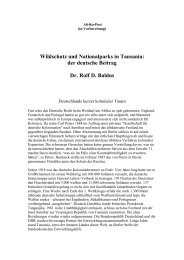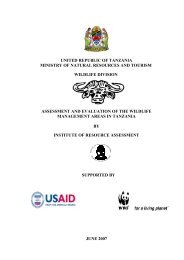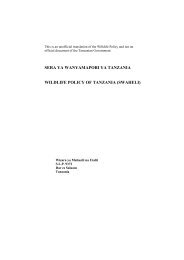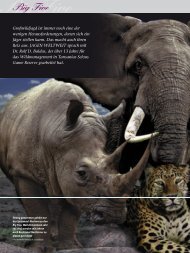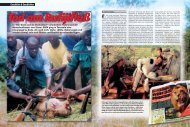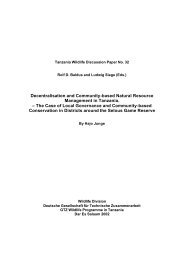African Indaba Articles - wildlife-baldus.com
African Indaba Articles - wildlife-baldus.com
African Indaba Articles - wildlife-baldus.com
Create successful ePaper yourself
Turn your PDF publications into a flip-book with our unique Google optimized e-Paper software.
• Poaching: strong upward trend• Hunting: reform rejected again by Director of Wildlife after elections• Government has granted mineral prospecting licenses for Selous despite internationalagreement that there must be no mining in World Heritage Sites• Kidunda Dam project at north-eastern corner of reserve goes ahead despite negativetechnical and environmental studies and expert agreement that project is not feasible:will lead to major ecological damage in northern (tourist) sector of Selous and todestruction of neighboring WMA.Bibliography:All quoted publications plus additional articles and sources on the Selous, SCP, CBC, tourist hunting etc. canbe found in: http://www.<strong>wildlife</strong>-<strong>baldus</strong>.<strong>com</strong> and on www.africanindaba.co.zaDisclaimer: The author worked as coordinator of the SCP from 1987 to 1993 and as Government Advisor inthe Wildlife Division between 1998 and 2005. All views and opinions expressed are, however, solely his ownand not necessarily those of his former or present employers. They are also not necessarily those of theconference organizers.Conservation, Wildlife & MarketsRe<strong>com</strong>mendations from the “Conservation, Wildlife & Markets” conference at the StrathmoreBusiness School, Nairobi, and its implications for Kenya’s <strong>wildlife</strong> policy reviewGuest Editorial by Dr Stephanie S. RomañachWildlife conservation and <strong>wildlife</strong> policy are particularly emotive topics in Kenya, often stimulating mediacoverage and intense debate. In 1977, Kenya imposed a ban on trophy hunting that is still in place today.The Kenyan government has retained ownership of <strong>wildlife</strong> as well as user rights for the <strong>wildlife</strong> resourceexcept for tourism. Despite these policies, Kenya has remained a popular destination among tourists, manychoosing to visit the country for its famous parks. However, much of the country is not suitable for tourismbecause of remoteness, lack charismatic species, or low densities of <strong>wildlife</strong>. Because alternative <strong>wildlife</strong>utilization options are not permitted, there is little scope for people living with <strong>wildlife</strong> to derive revenues from<strong>wildlife</strong>.As a result, wild animals are perceived by many Kenyans to be nothing more than a dangerous liability.This perception is enhanced by the increasing frequency and intensity of human-<strong>wildlife</strong> conflict in Kenya,which is widely publicized in the media. Correspondingly, <strong>wildlife</strong> populations inside and outside of protectedareas in Kenya have experienced serious declines in recent years, and without a change in policy,conservation prospects are bleak. Kenya is currently reviewing its <strong>wildlife</strong> policy, which could yield majorchanges and thus improve the prospects for conservation.In early November, I was invited to a conference on ‘Conservation, Wildlife & Markets’ held by theStrathmore Business School in Nairobi. I was asked to speak about the potential for trophy hunting tocontribute to <strong>wildlife</strong> conservation and management, and rural development in Kenya. Given that trophyhunting is such a contentious topic (especially in Kenya), I was concerned that discussion would beemotional and unscientific. This concern was amplified when I learned that an animal welfare organizationwas funding the conference. Thankfully, though, the conference organizers obtained financial support fromseveral organizations, thus ensuring a balanced agenda. The timing of the conference with the <strong>wildlife</strong> policyreview was coincidental, but potentially of great value.The 3-day conference opened on the morning of the 9th of November with an attendance of 100 – 150people. There was a line-up of 17 speakers from various backgrounds and specializations, including thosepracticing law, journalism, economics, and conservation. One of the goals of the conference organizers wasto ensure that the conference did not turn into an emotional, pro- versus anti-hunting debate. Speakers,109



